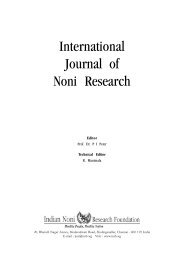International Journal of Noni Research - Noni Family
International Journal of Noni Research - Noni Family
International Journal of Noni Research - Noni Family
Create successful ePaper yourself
Turn your PDF publications into a flip-book with our unique Google optimized e-Paper software.
N. Mathivanan<br />
G. Surendiran<br />
Authors’ affiliation :<br />
N. Mathivanan<br />
G. Surendiran<br />
Centre for Advanced Studies in<br />
Botany, University <strong>of</strong> Madras,<br />
Guindy Campus, Chennai - 600 032.<br />
India.<br />
Correspondence to :<br />
N. Mathivanan<br />
Centre for Advanced Studies in<br />
Botany, University <strong>of</strong> Madras,<br />
Guindy Campus, Chennai, India.<br />
E-mail : prabhamathi@yahoo.com<br />
Chemical and biological properties<br />
<strong>of</strong> Morinda spp.<br />
Keywords : Hepatoprotective, M. citrifolia, M. pubscens<br />
Abstract : The present study was aimed to investigate various chemical and<br />
biological properties <strong>of</strong> M. citrifolia and M. pubescens. Chemical analyses<br />
<strong>of</strong> the fruit have revealed that most <strong>of</strong> the essential elements were present in<br />
higher amount in the fruits <strong>of</strong> M. citrifolia compared to M. pubescens.<br />
Manganese was present in high quantity in M. pubescens, whereas Calcium,<br />
Potassium, Phosphorus and Magnesium were found almost at par in both the<br />
fruits. The reducing sugars and lipids were present in high levels in the fruits<br />
<strong>of</strong> M. citrifolia whereas, the total soluble sugars, starch and crude fibers<br />
were high in M. pubescens. The natural antioxidant content was high in the<br />
fruit extracts <strong>of</strong> M. pubescens compared to M. citrifolia. The fruit extracts<br />
<strong>of</strong> M. citrifolia and M. pubescens effectively inhibited wide range <strong>of</strong> human<br />
and plant pathogens. The antimicrobial activity was more pronounced with<br />
M. citrifolia than M. pubescens. Further, the fruit extracts significantly<br />
inhibited the respiration rate in human and fungal pathogens. Both the fruit<br />
extracts showed excellent hepatoprotective effect against D-galactosamine<br />
intoxicated experimental rats. The fruit extracts <strong>of</strong> M. citrifolia and M.<br />
pubescens have also shown effective antidiabetic activity in alloxan induced<br />
experimental rats. This activity was more pronounced with M. pubescens<br />
than M. citrifolia.<br />
Introduction<br />
The genus Morinda is distributed worldwide (Wang et al., 2002) and the<br />
presence <strong>of</strong> as many as 80 different species has already been reported (Smith,<br />
1988). Morinda citrifolia, a small tree, grows predominantly along the tropical<br />
coasts and is extensively being used in folk medicine. Its antibacterial, antiviral,<br />
antifungal, antitumor, antidiabetes, analgesic, anti-inflammatory, immune<br />
enhancing activities have already been reported (Wang et al., 2002; Mathivanan<br />
et. al., 2005; 2006; Surendiran et al., 2006). Another related species, Morinda<br />
pubescens grows predominantly in vacant agricultural land and some <strong>of</strong> its<br />
medicinal properties were documented in the ancient literature. However, no<br />
scientific research has been carried out in our country on these two Morinda<br />
species and hence, the present study is focused to explore the potentials <strong>of</strong> M.<br />
Intl. J. <strong>Noni</strong> Res. 2007, 2(1-2) 62








